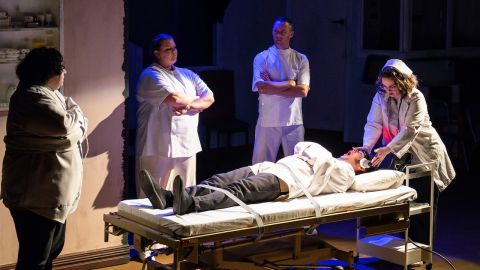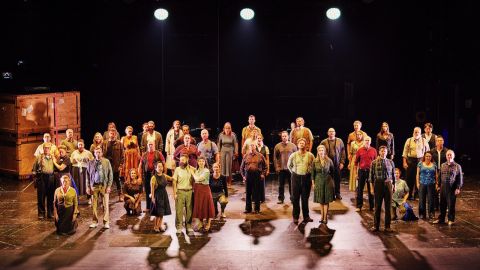Director’s Diary: Home, I’m Darling
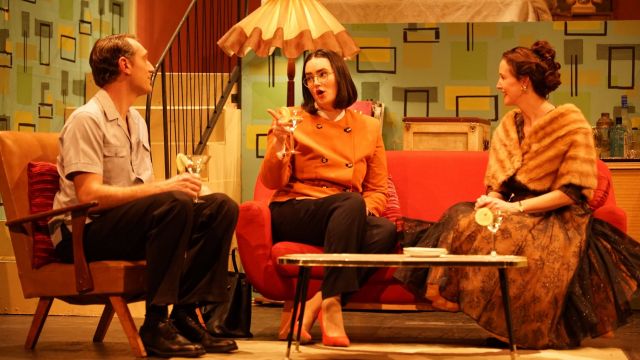
Therry Theatre at Arts Theatre, Adelaide
By Jude Hines.
Award-winning British playwright Laura Wade’s Home, I’m Darling is one of the gems of theatre that was dealt a cruel blow by COVID 19. Written for much loved actor Kathryn Parkinson, it was extensively workshopped by Theatr Clwyd in Wales, opening in 2018.
It moved to London, promptly winning two Olivier Awards, one for the Best New Comedy (2019). Within months, theatres went ‘dark’ all over the world and consequently, the run of this brilliant original comedy was cut short. Scheduled by both Melbourne and Sydney theatre companies, it just squeezed in for 2020 in Melbourne and was shelved until 2021 in Sydney, when theatre gingerly returned to our stages.
As a director, I regularly check the West End and Broadway for new and interesting plays and this captivating, amusing and often visceral play resonated powerfully with me as both a woman who works, and a mother.
The writing is explicit and powerful. Sentences with no full stops create dialogue that tumbles without pauses, the conversations are rich and often pithy and the post WW2 journey of women is a timely reminder that everything that both men and women have achieved is hard won. Amidst this is a love story where a couple, Johnny (Stephen Bills) and Judy (Alicia Zorkovic, who is in every scene) opt to live the life of the ‘50s in their perfectly pastel, Barbie-like house. I was ‘hooked’, and a three-year quest to work with a company who believed in this very provoking play enough to gain amateur rights was my challenge.
Therry Theatre celebrates 80 years of community theatre in 2023. It has been the training ground for television, theatre and international stars including Brian Wenzel from A Country Practice, Hugh Sheridan from Packed to the Rafters and renowned producer Robert Stigwood. It’s run completely by volunteers, many of whom wear several hats, including award winning Lighting Designer Richard Parkhill. Unlike other Adelaide companies, Therry has a 10-man team, many retired specialists in other fields, who construct the set at the start of rehearsals, thus ensuring that the cast rehearse on the set, allowing workshopping and workable blocking.
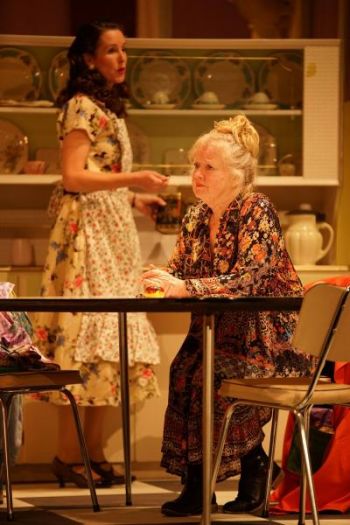
The fantastic ‘50s ‘wallpaper’ and checkerboard floor were, in fact the work of Mark Rogers, retired nurse, now book illustrator, who hand painted both. The two-story set was ambitious, expensive and quintessential for Johnny and Judy. And so, Home I’m Darling became the perfect play to celebrate Therry’s 80-year journey and contribution to South Australian theatre.
After gaining the rights, plays take many months in the planning, and whilst we had auditions in January 2023, over the months of preparation, for many reasons, I had a 50% cast turnover before rehearsals began. This turned out to be serendipitous because audiences are clear that all six characters are beautifully drawn and convincingly portrayed.
Prior to beginning rehearsals, each actor discussed their vision and background for their character, and to support becoming a ‘50s person, girls were given rehearsal stockings and rope petticoats, and the men explored handling hats.
Because this is such a visual show, Adelaide costumers Gillian Cordell and Sandy Faithful began the process by researching the looks and styles of the eras of this play. Gillian researches and sources costume gems; Sandy loves to sew, obsessively ensuring that actors feel and look good in clothing to support them in giving their best performance.
Seemingly joined at the hip, both love those aspects, and for this show, scoured Therry’s wardrobe department, Op Shops, private collections and, using 1950’s paper patterns, created beautiful gowns that looked brilliant on the actors and against the set.
To complicate their task, the play has two characters who live in the ‘50s (Johnny and Judy), two who live in the ‘now’, but flirt with the look and lifestyle of the ‘50s, Fran (Jessica Corrie) and Marcus (Adam Schulz), and two powerful women, Alex (Lani Gerbi) and Sylvia (Deb Walsh), who put the rabid into feminism, each epitomising strong, powerful modern women. The result was three different costume styles that meticulously supported the story. Our local daily paper commented, ‘Costumes from Gillian Cordell and Sandy Faithful are sensational.’ They were ‘chuffed’.
Set Designer Gary Anderson was clear from the outset that his greatest opportunity was creating an additional ‘character’, a set that transported the audience into the feel, style and detail of the 1950s. As early as January, he sketched a two-story English house that was perfect to allow Johnny and Judy to be a real couple who could create and live their perfect fantasy.
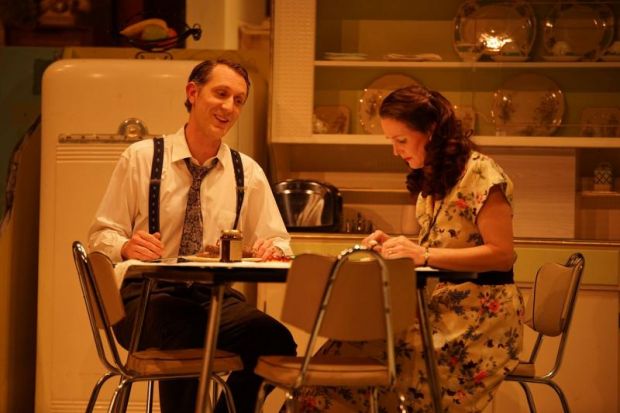
It was to be where Johnny was her ‘rock’ (rather like her idol Rock Hudson), and she, channelling Doris Day, could make perfect canapés, create soothing cocktails, and welcome him home, his slippers ready at the door, into their perfectly clean and decorated home. Gary commented that the usual challenge for non-professional companies is always budget, and so he trawled Op Shops, markets, on-line sites and friends’ homes to gather the vinyl chairs, breadbins, Laminex topped kitchen table, mustard green china cabinet and other bric a brac to build his ‘50s set and Judy’s perfect ‘doll’s house’.
Ironically, it was Lani Gerbi, who plays Alex, a very successful emancipated female Real Estate Manager, who opted to knit the Dolly Varden teapot cosy! A local critic described the set as ‘mind-boggling’ and a number of audience members queued to photograph the ‘50s memorabilia and the hand painted ‘wallpaper’.
I bordered on losing my sense of humour when it came to Properties, and fortunately started collecting things back in February. This is a play about ‘50s behaviour and culture, thus, it felt like endless cups of tea and eggless cake, made by me (as one cast member who has to eat cake is allergic to eggs), cocktails, salt dough devilled eggs and meat and three veg meals were crucial parts of the story.
Detailed photos of every setting in situ ensured that each piece was pre-prepared and in place. Note to self: look at the Props list before reading any more plays. Three teams, including cast, rotated through props management, plating cakes, pouring drinks, mixing the glue-like instant mash, resetting tables and furniture, in dimly lit precision.
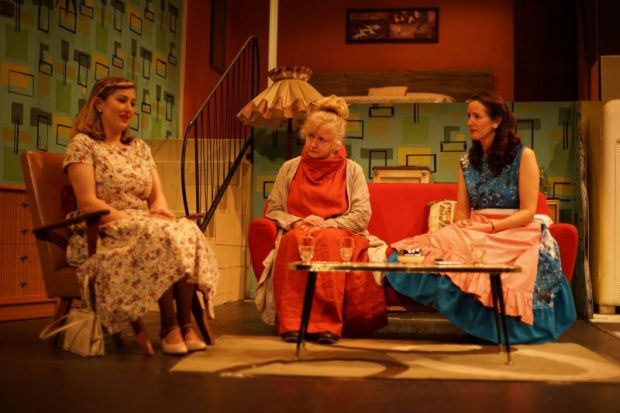
Scene and costume changes took time, so I used the top 10 number one hits from 1950 to 1959 to bridge scenes and entertain the audience. ‘How much is that Doggie in the Window’ was a huge crowd pleaser, while ‘Que, Sera, Sera’ became the favourite sing-along song.
Home, I’m Darling also gave me an opportunity for several of my professionally trained actors to be seen doing important, albeit unpaid work. Reviewer Mark Wickett said, ‘It's a beautiful examination of the benefits and pitfalls of nostalgia, with the pervasive attitudes that should have remained back there. It shows us the still-growing need for equality between the sexes.’ So, my job was done courtesy of skilled Production and Technical teams, a cast of six highly skilled actors and one of Adelaide’s oldest and most respected theatre companies.
What have I learned? The old adage that ‘the play’s the thing’ still holds true, because in this play, as in others, the play becomes our focus, our passion, and hopefully, our gift to our audiences.

